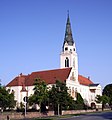Greek Catholic Church of Croatia and Serbia
| Greek Catholic Church in Croatia and Serbia | |
|---|---|
Church Slavonic | |
| Liturgy | Byzantine Rite |
| Part of a series on |
| Particular churches sui iuris of the Catholic Church |
|---|
|
Particular churches are grouped by liturgical rite |
|
Alexandrian Rite |
| Armenian Rite |
| Byzantine Rite |
| East Syriac Rite |
| Latin liturgical rites |
| West Syriac Rite |
The Greek Catholic Church in Croatia and Serbia
Although two eparchies are canonically linked, the church has no unified structure, nor an ecclesiastical province of its own, since the Eparchy of Križevci is suffragan to the Latin Church Archdiocese of Zagreb, and the Eparchy of Ruski Krstur is directly subject to the Holy See.
History
The Greek Catholic Church in Croatia has existed since the 16th century and was created by
Until 2001, the
After the formation of independent successor states from what had been
In 2003, a new
After those changes, the jurisdiction of the Eparchy of Križevci was confined to Croatia, Slovenia, and Bosnia-Herzegovina.
In 2013, all Catholics of Byzantine Rite in Montenegro were entrusted to the local Latin bishops, so the jurisdiction of Apostolic Exarchate of Serbia and Montenegro was reduced to
Liturgy and extent
The
The
Gallery
-
Križevci, Croatia
-
Cathedral of St. Nicholas in Ruski Krstur, Serbia
See also
- Catholic Church in Bosnia and Herzegovina
- Catholic Church in Croatia
- Catholic Church in Serbia
- Catholic Church in Slovenia
Notes
- Serbo-Croatian: Grkokatolička crkva u Hrvatskoj i Srbiji, Гркокатоличка црква у Хрватској и Србији
References
- ^ Catholic Hierarchy: Greek Catholic Eparchy of Križevci
- ^ Catholic Hierarchy: Greek Catholic Eparchy of Ruski Krstur
- ^ Križevačka eparhija: Biskup
- ^ Catholic Hierarchy: Bishop Đura Džudžar
- ^ "Grkokatolička crkva | Hrvatska enciklopedija". www.enciklopedija.hr. Retrieved 2023-07-20.
- ^ Acta Apostolicae Sedis, 93 (2001), p. 339.
- ^ Catholic Hierarchy: Greek Catholic Apostolic Exarchate of Serbia and Montenegro
- ^ Acta Apostolicae Sedis, 105 (2013), p. 187.
- ^ Catholic Hierarchy: Greek Catholic Eparchy of Ruski Krstur
- ^ "The Eastern Catholic Churches 2010" (PDF). Archived from the original (PDF) on 2015-09-23. Retrieved 2016-06-06.
External links
- Eparchy of Križevci (in Croatian)
- Apostolic Exarchate of Macedonia (2001-) on Catholic Hierarchy
- Apostolic Exarchate of Serbia and Montenegro (2003-2013) on Catholic Hierarchy
- Apostolic Exarchate of Serbia (2013-) on Catholic Hierarchy
- Article on Greek Catholics in Former Yugoslavia by Ronald Roberson on the CNEWA web site



